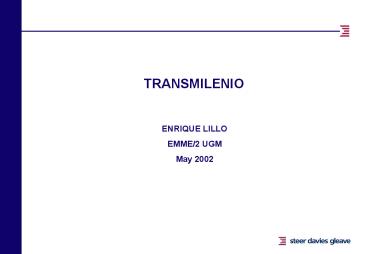TRANSMILENIO - PowerPoint PPT Presentation
1 / 43
Title:
TRANSMILENIO
Description:
TRANSMILENIO. ENRIQUE LILLO. EMME/2 UGM. May 2002. Bogot . 7 million people ... 1 million automobiles moving 19% of the population. 30 000 buses moving 72% of ... – PowerPoint PPT presentation
Number of Views:122
Avg rating:3.0/5.0
Title: TRANSMILENIO
1
TRANSMILENIO
- ENRIQUE LILLO
- EMME/2 UGM
- May 2002
2
Bogotá
- 7 million people
- Mean annual population growth of4,5 over the
last 10 years - 25 of Colombian GDP
- US 3 300 GDP per Capita
3
Transport indicators
- 1 million automobiles moving 19 of the
population - 30 000 buses moving 72 of the population
- Mean bus speed during peak hour 7 km/hr
- Approximately 650 bus lines
- Approximately 22 000 registered buses
- On average a transit rider spent 2 hours and 20
minutes in transport per day
4
Public Transport The Vehicles
Bus Corriente 26 65 passengers Year lt 90
Bta Ejecutiva 33 30 passengers Years 75 - 92
Bus Intermedio 12 68 passengers Year gt 91
Colectivos 16 15 passengers All years
Bus Ejecutivo 9 72 passengers All Years
Bta. Ejecutiva 4 30 passengers Year 93 gt
Source STT 1998
5
Public Transport The Bus Network
6
Demand for Public Transport Daily Pattern
7
Demand for Public Transport Socio-economic Strata
8
Demand for Public Transport Travel Distance
9
Demand for Public Transport Number of Transfers
10
Demand for Public Transport Passenger Load
Figures correspond to the heaviest load per
direction during the a.m. peak hour Source From
passenger counts, April 1999
11
Transmilenio Concept
- INFRASTRUCTURE
- Bus Only Lanes
- Transfer Stations
- Bus Stations
- BUS LINES
- Trunk Routes
- Feeder Lines
- New Transit Agency
- New Public Transport Providers
- Fare Collection System
- Remote Control System
- New Vehicles
12
Transmilenio Main Corridors
13
Transmilenio Stations
- Transfer Stations
- Main Located at the end of the main corridors
- Intermediate Located along any of the main
corridors
14
Transmilenio Stations
- Regular Stations
- Boarding and Alighting of Passengers
- Transfers between trunk lines
- Located along the main corridors
15
Transmilenio Feeder Zones
16
Transmilenio Feeder Trunk Interaction
17
Transmilenio Feeder Trunk Interaction
Feeder 1
Feeder 2
COMMON SPACE
FARE INTEGRATION
Trunk Route
18
Bus Operations Formation of bus queues in
stations
- r saturation degree Demand Rate / Service
Rate - Queue Length L 0.7r2/(1-r)
19
Bus Operations Operational Parameters
- x time in station / available time
- x frequency (time per bus)/ 3600
- example f 100 veh/h, t 30 sec
- x 30100 / 3600 0.83
- fm Maximum Frequency
- Maximum x 0,4
- 0,4fm t /3600
- fm1440 / t
- C Operational Capacity
- C passengers / hr
- C fm Bus Capacity 1440 Bus Capacity / t
20
Bus Operations Dwelling Time
- Tp to tp np
- to bus manoeuvring door operations time
- tp time per passenger
- npnumber of passengers bus capacity R
- R loading factor
21
Bus Operations Operational Capacity
- C1440/(to / bus capacity tpR) Single stop, one
vehicle
22
Bus Operations Capacity as a function of R
(demand)
23
Bus Operations Speed and Frequency
24
Bus Operations Fleet size and Frequency
25
Bus Operations Alternative 1 - Convoys
26
Bus Operations Alternative 2 Differentiated
Stops
- Segregated bus stops by destination
- Local and Express Buses using two lanes per
direction in the bus corridors
Platform A
Platform B
27
Bus Operations Station Design in Avenida Caracas
28
Strategic Modelling Objectives
- Forecast the demand
- Describe the riders
- Provide flexibility for simulation
- Create appropriate interface with operational
design - Provide functional and economic indicators
- Create and model that can be updated
29
Strategic Modelling Overall Design
Transmilenio Service Attributes
Transmilenio Demand
Transmilenio Routes
Transmilenio Riders
Revenue Sharing
Revenue Calculation
30
The Demand Surveys and Counts
- Public Transport Passenger and Vehicle Counts
(250 000 records) - Boarding and Alighting (20 000 records)
- Origin Destination Surveys on board ( 66 000
records) - Public Transport Users Counts in bus stops ( 3
000 records) - Traffic Counts at major intersections
- Stated Preferences (1 989 interviews)
31
Spatial Distribution of the Demand
- Origins
- Destinations
32
Analysis Zones
635 Zones 606 Inside the study area and 29
outside
33
EMME/2 Model
- 635 zones
- 1904 nodes
- 8509 links
- 6 modes
- 400 public transport lines
34
Value of Time
- Value of Time Estimated from SP survey
35
Results (1)
36
Results (2)
37
Results(3)
38
Results (4)
39
Results(5)
40
Sensibility Analysis Fare and Competition
- Financial Equilibrium 750
- 10 increase in fare creates a 10 reduction in
demand - With strong competition the equilibrium point is
15 higherand the demand drops 25
Weak Competition
Strong Competition
41
Sensibility Analysis Speed and Competition
- 5 km/hr less creates a 20 demand reduction
- With strong competition the demand drops 70
Weak Competition
Strong Competition
42
Most Common modelling errors (1)
- OD Matrices
- Obtained from household surveys
- Zoning detail is not appropriate for modelling
purposes - Lack of information
- Automatic adjustments
- Market segmentation
- Market segmentation criteria
- Not enough segments
- Wrong Models
- Fare system
- Different Users
- Erroneous simulation of pedestrian access
- Slow Models
43
Most Common modelling errors (2)
- Perception of the new system
- Commercial Speed
- New system Effect
- Some costs are not truly evaluated ( waiting
time, walking time, etc.) - Competition
- Fare
- Level of Service
- Changes in mobility patterns
- Peak Hour behaviour
- Changes in Land Use































